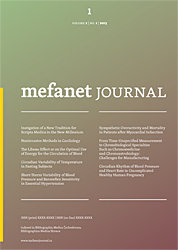
MEFANET Journal 2017; 5(2): 46
EDITORIAL MATERIAL
Editor’s preface
Daniel Schwarz
Institute of Biostatistics and Analyses, Faculty of Medicine, Masaryk University, Brno, Czech Republic
schwarz@iba.muni.cz
It is with great pleasure that we present the 2nd 2017 issue of the MEFANET Journal (MJ). MJ is dedicated to provide readers around the world with high quality peer-reviewed articles on a wide variety of topics related to applications of computer science and technology-enhanced learning in medical education. Its mission is to become the premier vehicle for disseminating information about MEdical FAculties NETwork (www.mefanet.cz), which covers all Czech and Slovak medical faculties as well as schools or faculties of health care sciences.
This second issue encompasses three original articles and an editorial report. The first original paper by Kristinikova et al. demonstrates students' ability to perform Evidence Based Practice and to ask PICOT formatted research questions. The authors work with undergraduates studying in a rehabilitation study program and conclude that the students are able to determine which of the uncovered evidence is of the highest significance in particular patient cases. Obročníková et al. focus on the continuous training of nurses and midwives in the light of the global, epidemiological and social problems related to malignant breast tumors and the patients’ quality of life. The third original research paper by Klempíř et al. describes an interactive web-based application for processing and analysis of data in neuroscience. The authors exemplify the feasibility of performing explorative data analysis on-line, with the use of NeuroEDA web-based application developed on the grounds of Shiny framework. This framework has been created around the popular R studio and has been recently and repeatedly proven to be a very useful tool for reactive programming. The editorial report by Komenda et al. recalls the 10th anniversary of the MEFANET conference. This event celebrated the jubilee of creating the network, starting the conference series and initiating plethora of professional links. Blažková et al. report on the launch of the SIMU project, which aims at revision of the curriculum of the General Medicine and Dentistry study programs at Masaryk University. The curriculum amendments will impact mostly the practical parts of teaching, which will employ a comprehensive range of medical simulation modalities, such as patient simulators, mannequins, standardized patients and virtual patients, in order to facilitate development of the 21st century skills, such as critical thinking, decision-making, clinical reasoning, crisis communication and teamwork.
I am sure that the readers will benefit from the information in the presented papers and it is my hope that this issue will stimulate further discussion and additional research. I would like to extend my sincere appreciation to the editorial members and reviewers, without whom this issue would not be possible. I would like to see the whole fifth volume of MJ as another valuable resource for the MEFANET community and a stimulus for further research into the area of medical education science. Readers are encouraged to submit both comments on these articles and their own relevant manuscripts.
September 2017

Daniel Schwarz
Editor-in-chief










